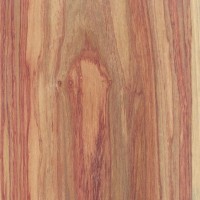 |
Common Name(s): Tulipwood Scientific Name: Dalbergia decipularis (also Dalbergia frutescens) Distribution: Northeastern Brazil Tree Size: 20-30 ft (6-9 m) tall, less than 1 ft (.3 m) trunk diameter Average Dried Weight: 60 lbs/ft3 (970 kg/m3) Specific Gravity (Basic, 12% MC): .88, .97 Janka Hardness: 2,500 lbf (11,120 N) Modulus of Rupture: No data available Elastic Modulus: No data available Crushing Strength: No data available Shrinkage: Reported to be stable in use, with shrinkage rates likely similar to other rosewoods. |
Color/Appearance: Heartwood is streaked with yellows, reds, oranges, and pinks. Color and figure can be highly variegated.
Grain/Texture: Pores are open and medium-sized. Grain is usually straight, with a fine texture.
Endgrain: Semi-ring-porous or ring-porous; very large earlywood pores grading down to medium latewood pores, sometimes arranged radially, very few to few; solitary and in radial multiples of 2-3; yellow and reddish heartwood deposits present; narrow rays not visible without lens, spacing fairly close; parenchyma diffuse-in-aggregates, vasicentric, unilateral, winged, and banded (marginal).
Rot Resistance: Reported as having a low decay resistance, although it is resistant to insect attack.
Workability: Tends to be difficult to work due to its high density; also has a blunting effect on cutters. Can be difficult to glue do to an abundance of natural oils and high density. Turns very well and takes a high polish.
Odor: Has a mild, fragrant odor when being worked.
Allergies/Toxicity: Although severe reactions are quite uncommon, rosewood in the Dalbergia genus, (such as Tulipwood), has been reported as a sensitizer. Usually most common reactions simply include eye, skin, and respiratory irritation. See the articles Wood Allergies and Toxicity and Wood Dust Safety for more information.
Pricing/Availability: Likely to be very expensive, and seldom available as boards. Tulipwood is most often seen as smaller turning stock, with its cost being on par with other scarce exotics in the Dalbergia genus.
Sustainability: Although Brazilian Tulipwood is not evaluated on the IUCN Red List of Threatened Species, it is listed on CITES appendix II under the genus-wide restriction on all Dalbergia species—which also includes finished products made of the wood.
Common Uses: Veneer, fine furniture, inlay, marquetry, musical instruments (percussion), and small turned objects.
Comments: Not to be confused with American Tulipwood, (more commonly referred to as Tulip Poplar or Yellow Poplar), Brazilian Tulipwood is considered a true rosewood in the Dalbergia genus.
Tulipwood is a stunningly beautiful hardwood which is in short supply. The tree itself is only found in a narrow geographical area, and it’s small enough to be considered a shrub: typically yielding very small and narrow boards. Because of these limitations, Tulipwood is generally reserved for very small specialty wood items and accent pieces.
- African Blackwood (Dalbergia melanoxylon)
- Amazon Rosewood (Dalbergia spruceana)
- Bois de Rose (Dalbergia maritima)
- Brazilian Rosewood (Dalbergia nigra)
- Burmese Blackwood (Dalbergia cultrata)
- Burmese Rosewood (Dalbergia oliveri)
- Cocobolo (Dalbergia retusa)
- East Indian Rosewood (Dalbergia latifolia)
- Honduran Rosewood (Dalbergia stevensonii)
- Kingwood (Dalbergia cearensis)
- Madagascar Rosewood (Dalbergia baronii)
- Siamese Rosewood (Dalbergia cochinchinensis)
- Sissoo (Dalbergia sissoo)
- Yucatan Rosewood (Dalbergia tucurensis)
Scans/Pictures: A special thanks to Steve Earis for providing the turned photo of this wood species.


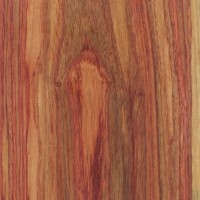
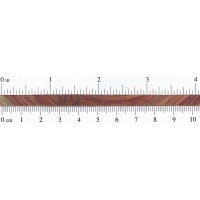
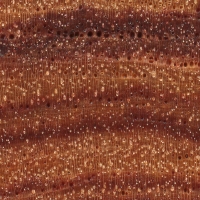
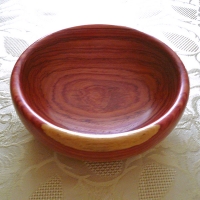



Can Brazilian Tulipwood be bleached? I’ve tried the A B two part bleach with no effect.
Interesting log of tulipwood from my collection. Sapwood with red streaks.
For comparison, last picture shows my other tulipwood that looks more typical.
recorder no. 2 please if possible. thank you for your time.
Do you know what country the wood came from? There are over 60,000 species of hardwoods, and it takes a great deal of university level training and a tremendously expensive microscope to precisely identify a wood.
Fortunately relatively few species are used commercially, and if the origin is known, then an experienced person may make a reasonable estimate of likely species.
A complication is the fact wood changes color over time.
I will give you a best guess if you can provide some more information.
Hi, I am so grateful for this site – I have learnt so much in regard to purchasing recorders – you have helped me so much with information and accuracy. I have done some woodworking (furniture design at uni), but am stumped as to the wood of this cupboard. Over 25 years old now…recorder images attached too – 1st is tulipwood, 2nd unknown, 3rd english walnut?, 4th cherrywood (according to the makers). If anyone can help in regard to the cupboard, that would be wonderful. The photos don’t do it justice – a deep orange with yellow undertones, and bright… Read more »
Hello Nikki, As WoodScientistDendrologist stated, it can’t be told for certain without the further information he suggested and a properly trained/informed wood specialist. However, being more-so an enthusiast, myself, I can say that, simply based on the hundreds of blanks I have viewed, bid-on and even, rarely, won at auction, your cupboard looks VERY much like it could possibly be constructed from Koa or maybe even Mango wood. Is there a chance that you, or it, reside(d) or originated in Hawaii? That would be another indicator to assist your identification. Whatever it “turns”-out (haha) to be, it certainly is very… Read more »
Has anyone else experienced this wood exploding while drilling? I was drilling a pen blank from tulip wood and one part made a popping sound then split and the other started smoking then less than a second later exploding making a loud bang and sending one half of the blank 2 meters from the drill. Drilled many different tropical woods with the same drill that day and none of them done that. I expect this is due to the high volume of oils in my piece vaporising and combusting due to an overheat. How can I prevent this from happening?
maybe you need to reduce the speed? And change the shape of the nozzle , drill, and cutter.
1 more
more pic
last pic
next pic, i could only upload 1 each time
i think this is tulipwood (the peradon gloucester is tulipwood) so can any one confirm. first photo is the gloucester the next 2 are my cue
Dalbergia Decipulares, only’s 4 references all registered for over 20 years, would be a very high risk trying to find
Ciotola in palissandro rosa fatta in Italia
does tulip wood shrink much?
I’ve never found exact shrinkage numbers, but it’s reported to be stable i service, so like other rosewoods, it probably has low shrinkage.